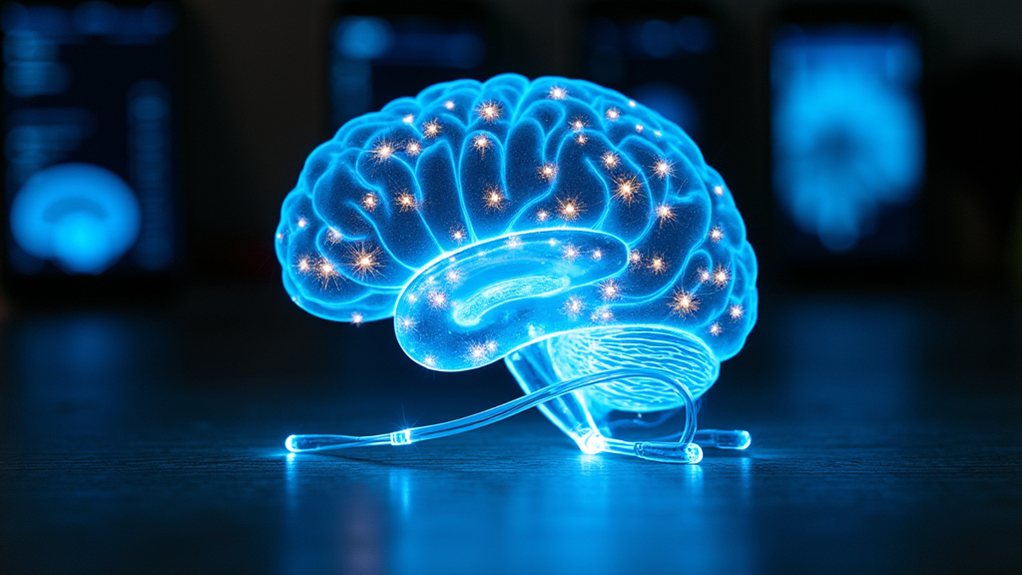Meta’s recent innovation in neural technology marks a significant milestone in the evolution of human-computer interaction.
Through sophisticated artificial intelligence, Meta has developed a system that interprets brain signals, effectively allowing individuals to communicate with computers via thought alone.
This breakthrough stands to redefine the paradigms of user interface by eliminating the need for traditional physical input devices.
With the potential to greatly enhance accessibility for those with motor impairments, the technology also prompts important considerations regarding privacy and ethical standards in the digital age.
As researchers and technologists explore this groundbreaking advancement, Meta’s mind-reading AI could reshape our interaction with technology and expand the horizons of what is possible in the realm of human potential.
Key Takeaways
- Meta, formerly known as Facebook, has achieved mind-reading using AI.
- The breakthrough allows users to control devices using their thoughts.
- The technology can greatly benefit individuals with disabilities, enhancing accessibility and quality of life.
- Privacy, ethical concerns, and data safeguarding are crucial in the development of this technology.
Understanding Meta’s Innovation
Meta’s innovation in mind-reading technology employs sophisticated algorithms to interpret neural signals, enabling a new dimension of interaction between humans and computers.
This profound advancement hinges on the precise decoding of brain activity patterns, which are translated into actionable commands by artificial intelligence systems.
The technology leverages neural imaging and electroencephalography (EEG) inputs as data sources, which are then processed through machine learning models.
These models are trained to discern the user’s intent based on the neural signal patterns.
As a result, the system can convert thought into action, creating a seamless interface that bypasses traditional input modalities.
The precision of Meta’s algorithms is critical, as it directly influences the efficacy and reliability of the mind-reading interface, shaping the future of intuitive and accessible technology.
Enhancing Accessibility Through AI
The integration of this groundbreaking technology into accessibility tools embodies a transformative step towards inclusivity for individuals with physical and communicative limitations.
By harnessing the power of AI to interpret neural signals for device operation, Meta’s innovation offers a paradigm shift in how we approach assistive technology.
The precise parsing and translation of brain activity into actionable commands can unlock unparalleled access and control for those previously marginalized by traditional interaction mechanisms.
This advancement not only augments the functional autonomy of users but also enriches their engagement with digital environments.
As AI continues to evolve, its application in creating adaptive interfaces stands to redefine the limits of accessibility, offering a new frontier of independence for individuals with diverse abilities.
Navigating Privacy and Ethics
Addressing the profound implications of Meta’s mind-reading technology necessitates a rigorous exploration of privacy and ethical frameworks to protect individual thought and data integrity.
The advent of such technology introduces complex challenges in safeguarding personal cognitive patterns, which are inherently private.
It is paramount to establish stringent data security protocols to thwart unauthorized access and exploitation of neural data.
Ethical guidelines must be meticulously crafted, emphasizing user autonomy and informed consent, thereby mitigating potential risks of cognitive surveillance and psychological manipulation.
Moreover, the stewardship of brainwave-derived information demands transparency in its collection, use, and storage, with clear user controls.
Establishing robust oversight mechanisms is crucial to foster trust and ensure that this revolutionary technology serves to enhance human capability without compromising individual freedoms.
Healthcare Advancements With AI
As mind-reading AI ushers in unprecedented opportunities, its application in healthcare promises to significantly enhance diagnostic and treatment methodologies for a variety of medical conditions.
The ability to interpret neural signals with high fidelity enables clinicians to gain deeper insights into cognitive and neurological disorders.
This could lead to more accurate diagnoses of conditions like epilepsy or Alzheimer’s disease by identifying abnormal neural patterns and correlating them with clinical symptoms.
Furthermore, AI-driven brain-computer interfaces (BCIs) may facilitate communication for patients with severe motor impairments, transforming their ability to interact with their environment.
Future Horizons and Hurdles
Meta’s mind-reading AI technology, while opening new frontiers in human-computer interaction, faces significant challenges such as ensuring accuracy and securing user trust.
The path ahead is replete with technical complexities, including the refinement of algorithms to interpret neural patterns with greater precision. Achieving a nuanced understanding of the brain’s intricate signaling and translating it into reliable commands for digital devices necessitates extensive research.
The imperative to safeguard sensitive neural data against breaches underscores the need for robust security protocols. As the technology advances, it must also navigate ethical quandaries, ensuring that applications align with societal norms and values.
Overcoming these obstacles is crucial for Meta to realize the full transformative potential of its mind-reading AI in enhancing human capabilities and reshaping our interaction with technology.









